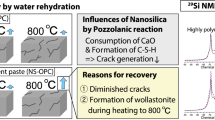Abstract
The effect of two different curing regimes on the polymerization degree of C-S-H in hardened cement pastes within 28 d were investigated by measuring the chemical environments of 29Si with magic angle spinning (MAS) nuclear magnetic resonance (NMR) and by analyzing the 29Si NMR spectra with deconvolution technique. The experimental results indicate that, at curing regime of constant temperature of 20 °C, the polymerization of C-S-H increases and then decreases with curing age, and the Al/Si ratio increases gradually with curing age, furthermore, the two non-bridging oxygen bonds of bridging silicate tetrahedra in C-S-H structure mainly bond to H+. At curing regime of variable temperature, the polymerization of C-S-H firstly increases then changes slightly and subsequently decreases with the temperature from low to high and then to low, and the Al/Si ratio firstly increases then keeps invariant and subsequently slightly decreases. Moreover, the temperature decreasing is advantageous for the Ca2+ to be bonded to the bridging silicate tetrahedra and entering into the interlayer of C-S-H structure. The polymerization of C-S-H at curing regime of variable temperature is higher than that cured at constant temperature, but the curing regime of constant temperature is more beneficial to the substitution of Al3 for Si4+ than that of variable temperature.
Similar content being viewed by others
References
Girão AV, Richardson IG, Porteneuve CB, et al. Composition, Morphology and Nanostructure of C-S-H in White Portland Cement Pastes Hydrated at 55 °C[J]. Cem. Concr. Res., 2007, 37(12): 1 571–1 582
Girão AV, Richardson IG, Taylor R, et al. Composition, Morphology and Nanostructure of C-S-H in 70% White Portland Cement-30% Fly Ash Blends Hydrated at 55 °C[J]. Cem. Concr. Res., 2010, 40(9): 1 350–1 359
Girão AV, Richardson IG, Brydson RMD. Composition, Morphology and Nanostructure of C-S-H in White Portland Cement-Fly Ash Blends Hydrated at 85°C[J]. Adv. Appl. Ceram., 2007, 106(6): 283–293
Elkhadiri I, Puertas F. The Effect of Curing Temperature on Sulphate-Resistant Cement Hydration and Strength[J]. Constr. Build. Mater., 2008, 22(7): 1 331–1 341
Cwirzen A. The Effect of the Heat-Treatment Regime on the Properties of Reactive Powder Concrete[J]. Adv. Cem. Res., 2007, 19(1): 25–33
Famya C, Scrivener KL, Atkinsonb A, et al. Effects of an Early or a Late Heat Treatment on the Microstructure and Composition of Inner C-S-H Products of Portland Cement Mortars[J]. Cem. Concr. Res., 2002, 32(2): 269–278
Ding QJ, Han JY, Huang XL. Effect of Large Amount of Fly Ash on Hydration Process of Portland Cement at the Early Stage[J]. Adv. Mater. Res., 2011, 233–235: 2 305–2 309
Pipat T, Rémi B. Modeling the Coupled Effects of Temperature and Fineness of Portland Cement on the Hydration Kinetics in Cement Paste[J]. Cem. Concr. Res., 2012, 42(3): 526–538
Yan PY, Wang Q. Influence of Fly Ash on the Compressive Strength of Concrete under Temperature Match during Conditions[J]. Concrete, 2008, (3): 1–3 (in Chinese)
Richardson IG. The Nature of C-S-H in Hardened Cements[J]. Cem. Concr. Res., 1999, 29(8): 1 131–1 147
Richardson I G, Brough A R, Brydson R, et al. Location of Aluminum in Substituted Calcium Silicate Hydrate (C-S-H) Gels as Determined by 29Si and 27Al NMR and EELS[J]. J. Am. Ceram. Soc., 1993, 76(9): 2 285–2 288
Richardson IG. Tobermorite/Jennite- and Tobermorite/Calcium Hydroxide-Based Models for the Structure of C-S-H: Applicability to Hardened Pastes of Tricalcium Silicate, β-dicalcium Silicate, Portland Cement, and Blends of Portland Cement with Blast-Furnace Slag, Metakaolin, or Silica Fume[J]. Cem. Concr. Res., 2004, 34(9): 1 733–1 777
Schneidera J, Cincottob MA, Panepucci H. 29Si and 27Al High-Resolution NMR Characterization of Calcium Silicate Hydrate Phases in Activated Blast-Furnace Slag Pastes[J]. Cem. Concr. Res., 2001, 31(7): 993–1 001
Justnes H, Meland I, Bjoergum J O, et al. NMR-a Powerful Tool in Cement and Concrete Research[J]. Adv. Cem. Res., 1990, 3(11): 105–110
Jakobsen A, Anderson S, Jakobsen HJ. Characterization of White Portland Cement Hydration and the C-S-H Structure in the Presence of Sodium Aluminate by 27Al and 29Si MAS NMR Spectroscopy[J]. Cem. Concr. Res., 2004, 34(5): 857–868
Grimmer AR. Structural Investigation of Calcium Silicates from 29 Si Chemical Shift Measurements[M]. In: Colombet P, Grimmer A-R (Eds.), Application of NMR Spectroscopy to Cement Science, Gordon and Breach, London, 1994: 113–151
Brough AR, Dobson CM, Richardson IG, et al. In Situ Solid-State NMR Studies of Ca3SiO5: Hydration at Room Temperature Using 29Si Enrichment[J]. J. Mater. Sci., 1994, 29(15): 3 926–3 940
Jeffrey JC. The Nanostructure of Calcium Silicate Hydrate[D]. Xi’an: Northwestern University, 2003
Author information
Authors and Affiliations
Corresponding author
Additional information
Funded by the Major State Basic Research Development Program of China (973 Program) ( No. 2009CB623201)
Rights and permissions
About this article
Cite this article
Ding, Q., Hu, C., Feng, X. et al. Effect of curing regime on polymerization of C-S-H in hardened cement pastes. J. Wuhan Univ. Technol.-Mat. Sci. Edit. 28, 715–720 (2013). https://doi.org/10.1007/s11595-013-0758-6
Received:
Accepted:
Published:
Issue Date:
DOI: https://doi.org/10.1007/s11595-013-0758-6




